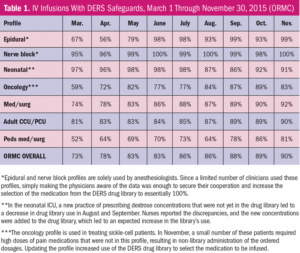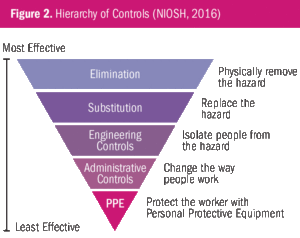Using Data Analytics to Change Behavior
IV medication safety improvement initiative
The overall goal of the initiative was to increase nurses’ compliance with selection of the medication to be infused from the DERS drug library. The question was, how could ORMC bring about the desired change in behavior? The Hierarchy of Controls advocated by the National Institute of Occupational Safety and Health (Figure 2) considers “administrative controls” (training and education) to be a less effective means to avoid exposing employees—or, in this case, patients—to potential harm.
With IV infusions, the best example of higher-level “engineering controls” is to integrate the smart pump system with the electronic health record (EHR). Interoperability automatically engages DERS for every infusion and pre-populates the pump with the ordered infusion parameters from the EHR. However, for many hospitals, interoperability is not a present reality. Another way to nurture compliance with smart pump technology and attention to the alerts is to optimize the smart pump drug library (Institute for Safe Medication Practices [ISMP], 2007). This increases the credibility of alerts, eliminates discrepancies between the drug libraries and actual practice, and makes it easier for nurses to select the medication from the drug library for every infusion.
Issues
To achieve this goal at ORMC, the following issues needed to be addressed:
Nurses were unaware of the lack of safeguards when the drug was not selected from the drug library and thus underappreciated the risk.
Nurses could not easily inform pharmacy about discrepancies between the smart pump drug libraries and actual practice.
Due to the lack of reporting from nursing, pharmacy was unaware of discrepancies that interfered with nurses’ use of the DERS drug library.
Without effective pharmacy-nursing collaboration to help optimize the drug library, it was not always easy for nurses to “do the right thing.” As a result, nurses did not always use the drug library to select the medications to be infused.
To address these issues and achieve the goal of increasing nurses’ selection of medications from the drug libraries, ORMC employed the methods shown in Table 1. 
Education
The nursing educators invited clinical pharmacy leadership to speak to all nurses at the 2015 Nursing Annual Education sessions about the importance of using DERS. This was also emphasized in training for newly hired nurses and in face-to-face discussions with nurses at the bedside.
Easier reporting
A “drug hotline” and designated email address made it easy for nurses to submit valuable feedback. Such feedback helped identify changes that pharmacy needed to make to the smart pump drug library. Regular IV Safety Improvement bulletins encouraged nurses to inform pharmacy of any needed improvements to the DERS drug library—for example, if a drug limit was not in alignment with actual practice and thus frequently overridden, or if a commonly used drug concentration was not in the drug library. Whenever a discrepancy report was received, a response was sent by return email, informing the nurse that the change would be made and when it would happen, or that further research/consideration would be needed. Rapid feedback was critical to the success of this initiative.
Change requests were submitted to the clinical pharmacy team for review. After review, revisions were made to the drug library, which was then double-checked by two pharmacists before being “pushed out” wirelessly to the pumps. A tip sheet notified clinicians of the changes. Seeing drug library improvements resulting from their efforts further motivated nurses to report discrepancies and, most importantly, to select the medication from the DERS drug library for all IV medication infusions.

